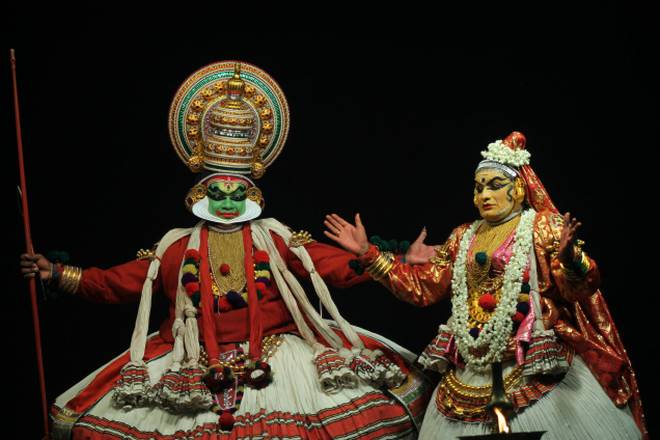Kathakali is one of the major classical dances amongst the eight Indian classical dance forms as identified by the Sangeet Natak Academy. The eight forms which the Sangeet Natak Academy recognises are – Kathak from North India, Manipuri from the North East, Sattriya from the eastern state of Assam, Odissi from Orissa, Kuchipudi from Andhra Pradesh, Bharatanatyam from Tamil Nadu, and Kathakali and Mohiniattam from Kerala.
Kathakali has its roots from Kerala. The foundation treatise of Kathakali can be traced in the ancient Sanskrit texts of Natya Shastra. The Natya Shastra is ascribed to Bharata muni which as per our historic records was compiled between 500 BCE and 500 CE. The term Kathakali is an amalgamation of Sanskrit words Katha meaning “story, folklore or conversation” and Kali meaning “entertainment and art”. This form of classical dance exemplifies the abiding fight between good versus the evil. This dance form is designed around plays called Attakatha (approved narrative), written in Sanskrit combined with Malayalam which we say Sanskritized Malayalam. These Attakathas revolves around Hindu texts such as the Ramayana, the Mahabharata, Nala Damayanti and Bhagavata Purana.
It is believed that Kathakali emerged during a time when women were restricted within four walls of a household. The staunch Hindu culture prevented women’s participation in several art forms. Though women played an integral part in the Attakathas still they were prevented in performing Kathakali which had men executing the roles of women characters as well.
Though women played an integral part in the Attakathas still they were prevented in performing Kathakali which had men executing the roles of women characters as well.
Our patriarchal society had always considered Kathakali to be a male art form. The roots of Kathakali are debatable. Some say it stemmed during the Bhakti movement and was performed by soldiers. The plays were written by the King/Prince. Since the soldiers were well trained in the martial art form of kalari, it called for meticulous exercises as part of the training. It gave way to the practice of body massages by feet (chavitty uzhichil) and this was one of the major reasons why women were prohibited in performing this form of dance.
Our history is the proof that though females were forbidden from performing Kathakali during the years when it made its mark, later nothing could stop women from training themselves in this dance form later on. The first female to perform in a Kathakali concert was Kartyayani from Tripunithura and since then there has been no looking back. Women dancers took charge; they enacted the female characters like Sita, Draupadi, Damayanti and Kunti. They also handled male characters like Krishna and many others. Dance during the colonial era was considered a very lowly profession so matrimony was another hindrance which came in the way of women dancers. Many of them left the dance practice post-marriage.
Also read: Bharatanatyam In The Wild: Claiming Our Bodies And Spaces Through Dance
During the mid 20th century, several women flocked in to learn Kathakali but could not make it up to the stage. However, there was one odd woman Chavara Parukutty who defied all patriarchal glances and norms and dared to become a professional dancer. She struggled to make a living out of it. Such was her love for the dance that she created history by performing even at a ripe age – a fact which all dancers should respect. Why only dancers? Even the staunch Hindu reformers who posed a hindrance for women from performing Kathakali should bow before her.
Casteism played a major role and gradually Kathakali grew popular when the rich and upper caste families started showing interest in this dance form. Back in those days, it was a matter of pride to own a troupe of Kathakali dancers. Namboodiri families and nobility played a remarkable role in augmenting art. Dr Haripriya Namboodiri is a rarity in the world of Kathakali — a full-time, professional female artist. Breaching a centuries-old, strictly guarded male bastion, the petite performer has made a mark as a sthree vesham specialist in a gamut of roles that include Kunti, Rukmini, Sita, Damayanti, Poothana and Lalitha. Institutes were formed which trained artists in this dance form. These institutes posed a problem to the students who did not join the classes. They struggled for independent existence but very few were taken seriously.
Furthermore, our gender biased society denied admission to women. Here again, women had to fight out their lone battle to learn this dance form and perform on stage. Sometimes it resulted in women-only groups performing in different parts of Kerala. A big round of applause for them for their success in staging Kathakali Attakathas and designing a collateral space for Kathakali and women. Though there were several factors which discouraged a woman to learn Kathakali and perform on stage the artists and Gurus were always willing to accept women and teach them the art.
women had to fight out their lone battle to learn this dance form and perform on stage. Sometimes it resulted in women-only groups performing in different parts of Kerala.
On women’s role in Kathakali writes Haripriya Namboodiri in the Hindu that there had been an upheaval in women’s involvement in Kathakali. Women are taking deliberating efforts to perform the plays that are physically strenuous. They have proved that nothing can stop them from making the effort. This has created a more positive outlook and acceptance from the critics. A whole new generation of women is coming up as competent artists and they do not want to make compromises in their artistic freedom. They are willing to suffer the hardships in their path to move centre stage. Having donned the make-up and costume, they are out to prove that they are no less than their male counterparts. This is a welcome change and has persuaded viewers to accept and appreciate them.
Before I wind up, I would like to brief the readers on certain details of this dance form. The choreography of Kathakali is based on sign language. Hastamudras (Hand Gestures) and Navarasas (nine emotions) are integral features of this dance form. The dialogues are conveyed through the Hastamudras and the Navarasas expresses the emotions. There are 24 major mudras and several minor ones. The nine emotions to create bhava among the audiences are: Shringara, Hasya, Roudra/Krodha, Veera, Karuna/Shoka, Bhayanaka, Bheebhatsa, Adbhuta and Shanta rasas.
Of all the eight classical dance forms, Kathakali has the most complicated costumes including head gears, facial masks and evocative painted faces. The makeup follows a detailed code that helps the audience to easily identify the quintessential characters such as the Hindu deities, demons, sages, animals and characters of a story.
Seven rudimentary makeup types are used in characters. Tati (red) denotes an evil character. Certain makeups with green face represent valour. Face makeup with red dots or lines adorning the cheeks or a red-coloured moustache or a red-highlighted beard constitutes evil inner nature. Others having a full face and beard coloured red represent evil characters. Kari (black) is the colour code of forest dwellers, hunters, and middle ground character. Demons (Rakshas) are also painted black but with highlights or patches of red. Yellow is the custom code for saints, vagrants, and women. Minukka (radiant, shining) with a warm yellow, orange or saffron exemplifies noble, unimpeachable feminine characters such as Sita and Panchali. Further details on costumes can be read here.
Also read: Revelations: Celebrating LGBTQ Stories Through Bharatanatyam
Kathakali is no more a dance form that is only confined to men. Ignoring the hindrances, the women folks have forged ahead in long strides. Not to forget the works of the great danseuse Mrinalini Sarabhai who was trained under the fabulously fabled guru Thakazhi Kunchu Kurup. Kathakali is now practically synonymous with women. It’s time we encourage more young women scholars to learn Kathakali.
Featured Image Source: The Hindu
About the author(s)
Rimli Bhattacharya works in the corporate sector. She is also a trained Indian Classical Dancer in Kathak and Odissi. Rimli has been awarded a Star Blogger by team Bonobology for her essay “Running a solo Marathon”.




